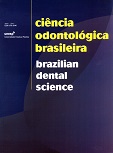Avaliação da resistência à fratura de dentes bovinos despolpados após três técnicas restauradoras: estudo in vitro
DOI:
https://doi.org/10.14295/bds.2005.v8i3.428Abstract
Neste estudo foi avaliada a resistência à fratura de cem dentes bovinos despolpados, restaurados por três diferentes técnicas adesivas e submetidos a ensaios de cisalhamento. Os dentes foram seccionados nos terços incisal e apical para padronização de forma e tamanho e divididos em cinco grupos experimentais (G1 a G5), com vinte dentes cada. O grupo G1 foi reservado para controle. Os dentes dos demais grupos tiveram seus condutos radiculares instrumentados, obturados com cones de guta-percha e receberam preparos cavitários para padronizar a espessura do tecido remanescente. No grupo G2 a guta-percha foi removida até o nível da junção esmalte-cemento e os dentes foram mantidos abertos para os testes de cisalhamento. No grupo G3, até 3mm além e, nos grupos G4 e G5 a remoção foi 8mm para apical da junção esmalte-cemento. Ainda nos grupos G4 e G5, pinos de resina composta pré-polimerizada foram cimentados nos condutos Os dentes dos grupos G3 a G5 foram restaurados em seguida com sistema adesivo e resina composta. Os dentes restaurados foram embutidos em blocos de resina acrílica, passaram por termociclagem (500 ciclos de 30 segundos em água a 5oC e 55oC) e foram armazenados até a execução dos ensaios, em água destilada a 37oC em estufa. Os ensaios de cisalhamento foram realizados em uma máquina de ensaios Instron. Os dados foram submetidos à ANOVA e teste de Tukey com nível de significância de 5%. Os valores obtidos não mostraram diferença estatística significante entre os grupos restaurados G3, G4 e G5. A utilização de pinos de resina não melhorou a resistência à fratura sob as cargas de compressão.
Downloads
Downloads
Published
How to Cite
Issue
Section
License
Brazilian Dental Science uses the Creative Commons (CC-BY 4.0) license, thus preserving the integrity of articles in an open access environment. The journal allows the author to retain publishing rights without restrictions.
=================




























